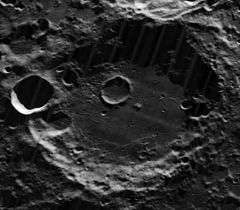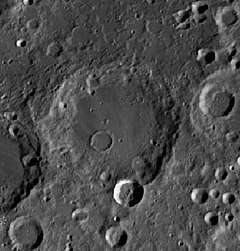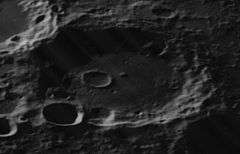Stefan (crater)
Stefan is a lunar impact crater on the far side of the Moon, just beyond the northwestern limb. Attached to the western rim is the slightly smaller crater Wegener, and close to the eastern rim is Rynin.
 Oblique Lunar Orbiter 5 image, facing west | |
| Coordinates | 46.0°N 108.3°W |
|---|---|
| Diameter | 125 km |
| Depth | Unknown |
| Colongitude | 110° at sunrise |
| Eponym | Joseph Stefan |


As with many craters of this size on the Moon, the outer rim has been worn by impact erosion and the edge and inner wall are generally pitted with small craterlets. The southern edge of the rim in particular has been damaged by impacts, and is overlain by the satellite crater Stefan L. This bowl-shaped crater lies at the center of a small ray system, which is indicative of a relatively young impact.
The interior floor of Stefan is a generally level surface that is marked by several impacts. The most notable is a ring-shaped crater rim projecting up through the southern half of the floor. Near the midpoint is a low hill, possibly the buried remnant of a central peak.
Stefan lies at the approximate margin of the Coulomb-Sarton Basin, a 530 km wide impact crater of Pre-Nectarian age.
Satellite craters
By convention these features are identified on lunar maps by placing the letter on the side of the crater midpoint that is closest to Stefan.
| Stefan | Latitude | Longitude | Diameter |
|---|---|---|---|
| L | 44.6° N | 107.7° W | 26 km |
References
- Andersson, L. E.; Whitaker, E. A. (1982). NASA Catalogue of Lunar Nomenclature. NASA RP-1097.CS1 maint: ref=harv (link)
- Blue, Jennifer (July 25, 2007). "Gazetteer of Planetary Nomenclature". USGS. Retrieved 2007-08-05.CS1 maint: ref=harv (link)
- Bussey, B.; Spudis, P. (2004). The Clementine Atlas of the Moon. New York: Cambridge University Press. ISBN 978-0-521-81528-4.CS1 maint: ref=harv (link)
- Cocks, Elijah E.; Cocks, Josiah C. (1995). Who's Who on the Moon: A Biographical Dictionary of Lunar Nomenclature. Tudor Publishers. ISBN 978-0-936389-27-1.CS1 maint: ref=harv (link)
- McDowell, Jonathan (July 15, 2007). "Lunar Nomenclature". Jonathan's Space Report. Retrieved 2007-10-24.CS1 maint: ref=harv (link)
- Menzel, D. H.; Minnaert, M.; Levin, B.; Dollfus, A.; Bell, B. (1971). "Report on Lunar Nomenclature by the Working Group of Commission 17 of the IAU". Space Science Reviews. 12 (2): 136–186. Bibcode:1971SSRv...12..136M. doi:10.1007/BF00171763.CS1 maint: ref=harv (link)
- Moore, Patrick (2001). On the Moon. Sterling Publishing Co. ISBN 978-0-304-35469-6.CS1 maint: ref=harv (link)
- Price, Fred W. (1988). The Moon Observer's Handbook. Cambridge University Press. ISBN 978-0-521-33500-3.CS1 maint: ref=harv (link)
- Rükl, Antonín (1990). Atlas of the Moon. Kalmbach Books. ISBN 978-0-913135-17-4.CS1 maint: ref=harv (link)
- Webb, Rev. T. W. (1962). Celestial Objects for Common Telescopes (6th revised ed.). Dover. ISBN 978-0-486-20917-3.CS1 maint: ref=harv (link)
- Whitaker, Ewen A. (1999). Mapping and Naming the Moon. Cambridge University Press. ISBN 978-0-521-62248-6.CS1 maint: ref=harv (link)
- Wlasuk, Peter T. (2000). Observing the Moon. Springer. ISBN 978-1-85233-193-1.CS1 maint: ref=harv (link)